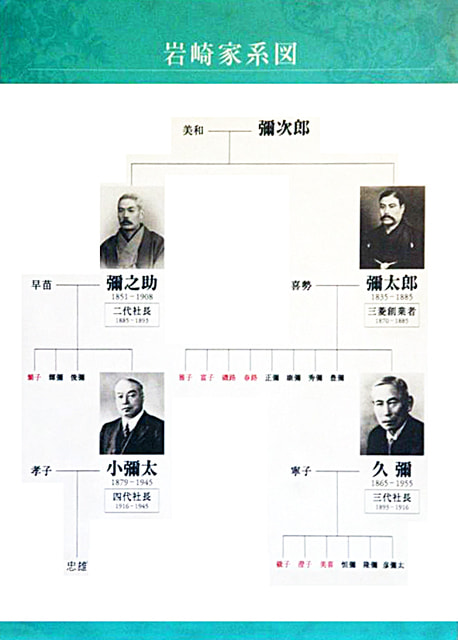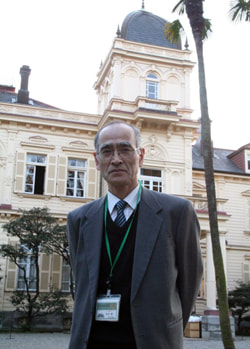
Mr. Shuichi Matsui, a chief of Kyu-Iwasaki-tei Teien Service Center.
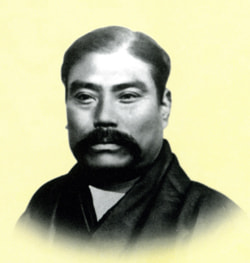
Mr. Yataro Iwasaki, the Mitsubishi combine founder (from a brochure "Mitsubishi Profile")
We talked with Shuichi Matsui, a chief of Kyu-Iwasaki-tei Teien Service Center.
Q. There is Tonogayato Teien (Garden), which was once the Iwasaki family's second house, in Kokubunji City, Tokyo, isn't there?
Matsui: Tonogayato Teien was purchased by Hikoyata Iwasaki as the Iwasaki family's second house in 1929. Hikoyata was the eldest son of Hisaya Iwasaki, the second head of the family. Hikoyata also had profound knowledge of the landscape gardening. Tonogayato Teien has been also known as "Garden of Mokkoku (Ternstroemia gymnanthera)." Mokkoku is an evergreen tree, and has very soft bark. It is called the king of garden trees. The garden was constructed making use of the slope of Tonogayato. There is also a spring, so it has a very good structure as a garden. The present four metropolitan gardens out of nine were owned by the Iwasaki Family. All the gardens were donated to the Tokyo Metropolitan Government. This Kyu-Iwasaki-tei Teien was confiscated during the postwar settlement rather than donated. It was the way things were.
Q. Was this garden the Iwasaki family's principal residence in the prewar period?
Yes, this was the Iwasaki family's principal residence. There was a historical process before the garden was converted to the family's residence. Yataro Iwasaki, the founder of the Mitsubishi financial group, purchased this land, which was once owned by the Sakakibara family of the Echigo Takada clan as their residence in Edo, in 1878. The Sakakibara family was a distinguished family which was called one of the big four in the Edo Period. Since the land was a strategically important site from which the north of Edo Castle could be watched, the Sakakibara family was placed there. Geopolitically speaking, it is located at the east end of the Musashino hilly land, and a sweeping view of Mount Tsukuba and Boso Peninsula can be seen from the east end of the Hongo tableland. Therefore, it is said that the place was very important from a strategic viewpoint. During the Meiji Restoration, the head of the Sakakibara family took the Imperial forces' side, but 68 retainers of the family joined the Shogunate forces and entered the Boshin War. This fact has been revealed recently. Since the Chinese character for "Sakaki" is composed of Chinese characters for "wood" and "god," the retainers called themselves "Shinboku-tai," or god's wood corps, and entered the war. However, most of them were killed in the war, and the survivors, together with Takeaki Enomoto, went to Goryokaku in Hakodate, Hokkaido. It is said that most of the survivors were also killed there. Japan experienced the turbulent age from the late Edo to Meiji Periods. There is even a rumor that the area around Kyu-Iwasaki-tei is still haunted by spirits of the war dead. (continued in the lower column)
The family tree of the Iwasaki family
It starts from Yajiro, the father of Yataro Iwasaki of the Mitsubishi financial combine founder. And it leads to Yanosuke of the second president, Hisaya of the third president and Koyata of the fourth president.

Q. How was the residence when Sukeshige Makino, the domain governor of the former Maizuru domain, owned it in the Meiji Period?
In the Edo Period, feudal lords had their second houses and villas in Edo, but there were the abolition of feudal domains and establishment of prefectures in 1871, so many feudal lords and heads of families returned to their native provinces. As a result, many unoccupied houses were left in a state of ruin. Then, those houses came under the control of the Meiji Government. As for this garden, the residence was once owned by the Sakakibara family, and then it was sold to Toshiaki Kirino, who was also known as Hanjiro Nakamura, or "Hanjiro the killer." The residence was owned by Kirino for a while, but he was killed in the Seinan War in 1877. Since the head of the family was dead, the residence was once again returned to the Meiji Government. Then, it was owned by Sukeshige Makino, the domain governor of the former Maizuru domain, but it seems that he only had the right of ownership. There is no material that proves Makino had lived in the residence. Subsequently, Yataro Iwasaki obtained the residence. He bought it for 34,000 yen. It was an extraordinary high price at that time. In those days, the general land price per tsubo (3.3 square meters) was 2 rin 5 sen. It is said that 30 to 40 million yen was spent during the Seinan War, and that Yataro undertook all the troop and ammunition transportation, making use of his marine transportation business, and spent about 3 million yen, 10 percent of the total war expenditure. Yataro purchased this land in the following year. In addition, he purchased Rikugien Garden (approximately 397,000 square meters) and Kiyosumi-teien Garden (approximately 99,000 square meters) in 1878. He transferred the head office of his company from Osaka to this place in Tokyo and named his company "Mitsubishi Shokai" in 1874. At that time, his house was located near the Tenjin shrine at Yushima Umezono-cho, but moved in this residence in 1882. (continued in the right column)
Although he bought the land and house from Makino, it seems that he was unconcerned with the house. Since he loved gardens, he devoted himself to restore this garden. He undertook a water supply works in this area from 1879 to 1880. He had water pipes laid in time for the third national products fair held at the Ueno Museum in 1881. It is said that a pond located here was filled with the city water, but there is no material to prove it. Although some people say that the pond was located in this garden, there is also no material regarding the pond. The present-day depressed ground might be the site of the pond.
Yataro Iwasaki said that he would build a superb house at this place someday, but he died in 1885. Then, Hisaya, son of Yataro Iwasaki, succeeded the head of the Iwasaki Family. One year after Yataro's death, Hisaya went to the United States and studied at the University of Pennsylvania. Hisaya returned to Japan five years later, and took up his position as the vice president of Mitsubishi. He assumed office as the president at the age of 29, and got married to a daughter of the Hoshina family. It is said that the guesthouse of this style was built as a wedding present. The Japanese-style residence which was built along with the guesthouse had a total floor space of approximately 1,800 square meters and was comprised of more than 20 buildings. It was a magnificent project, and took more than three years for completion.
Q. Was this Western-style house built with colonial style because Hisaya studied in the United States?
Well, it had a great influence. Although, in the first draft, British architect Josiah Conder planned to build the residence with stones and bricks, Hisaya stuck with wood construction. The first to fourth drafts are preserved, but strangely, there is no final draft. The roof shape of the present-day building is slightly different from that on the fourth draft which is owned by Mitsubishi Estate Co., Ltd. Buildings are usually enlarged and rebuilt after their completion, so the shape is different from that on the final draft.(continued in the lower column)
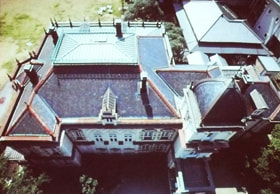
Overall of Kyu-Iwasaki-tei
The Survey map of Kyu-Iwasaki-tei
It is understood that its reconstruction was repeated in every age.

Q. Were both Japanese-style buildings and Western-style buildings built from the beginning?
Well, in the Meiji Period, construction of Western-style buildings was a supreme directive of the country. So guests were welcomed at Western-style buildings. That is to say, Western-style buildings were places of entertainment. It was such a period. Therefore, Conder was invited from England, and these Western-style buildings were built one after another. The construction of Western-style buildings reached a peak during the period when Iwasaki's residence was built. Conder also fostered competent disciples, including Kingo Tatsuno and Tatsuzo Sone, who would succeed his intention. Until then, there was no teacher who could actually teach Western architecture. This situation gradually changed with times. For example, Japan defeated Russia in the Russo-Japanese War - since a small country beat a large country, Japan was recognized as an advanced nation. What were the conditions to be an advanced nation? In order to enhance its national prestige, an advanced nation should welcome guests with its culture. Therefore, visitors were welcomed at Japanese-style buildings other than Western-style buildings. Until then, visitors passed through gates, and were entertained in Western-style buildings. However, the manner was changed. When visitors passed through gates and entered into undulating gable entrances, they saw that Japanese-style carpets were laid throughout the entrances. Those changes were made after the Russo-Japanese War. Architecture culture is interesting. Although there were political and financial factors and cultural trends, Japanese cultures were changed while being strongly affected by politics. There was such a trend of the times.(continued in the next page)
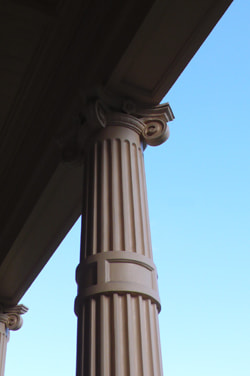

Mr. Shuichi Matsui, a chief of Kyu-Iwasaki-tei Teien Service Center.

Mr. Yataro Iwasaki, the Mitsubishi combine founder (from a brochure "Mitsubishi Profile")













